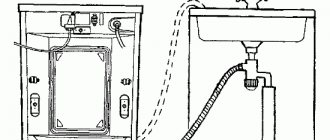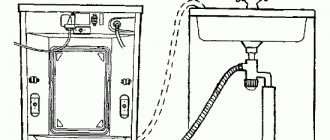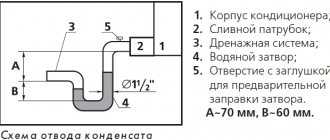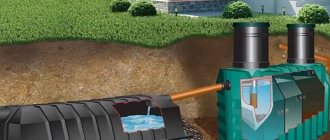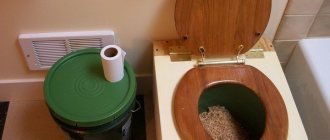A clogged drain is a serious problem, especially if it has caused the toilet to stop functioning.
In general, eliminating such troubles is a plumber’s priority, but many people prefer to do this work themselves.
Firstly, for the sake of economy; secondly, to do everything carefully: the invited master is usually not delicate and after him you have to clean up a lot of dirt. This material will tell you how to clean a toilet.
Causes of a clogged toilet
To prevent such problems from occurring, it is important to understand what causes them.
In city apartments, traffic jams are formed by:
- a rag or sponge that fell into the toilet when pouring water from a bucket;
- large remnants of food unsuitable for canned food. Tea leaves and coffee grounds pose a serious danger, especially if deposits have already begun to form in the pipe;
- remnants of building mixtures: plaster, putty, tile adhesive. Having a much higher density compared to water, they settle in the pipe, harden and quickly render the sewer unusable;
- toilet paper. If the pipes are new, you can throw toilet paper down the toilet - it disintegrates in water. But you shouldn’t throw paper into an old sewer, which is probably already partially overgrown;
- lime and other mineral deposits. They are formed by salts contained in water.
In private houses, errors during sewer installation are added to the reasons mentioned:
- using pipes of smaller diameter than required. The risers and the section of the lounger after the toilet should be laid with a pipe with a diameter of at least 100 mm;
- laying horizontal pipes with insufficient or, on the contrary, excessive slope. In the first case, the wastewater moves with weak pressure and partially settles in the pipe; in the second, the water runs out too quickly and does not have time to wash away the heavy insoluble fractions, so they also remain in the pipe. The optimal slope for sewer pipes with a diameter of 100 mm is 0.02 (2 cm per meter), the minimum is 0.012 (1.2 cm per meter);
- installing the toilet too far from the riser. This distance is regulated by standards and according to them cannot exceed 1 m;
- lack of a vent pipe. Without communication between the sewer and the atmosphere, the drains slow down either due to the rarefaction of the environment behind them, or because they are supported by gases formed in the sewer and septic tank;
- pipe freezing. This happens if the outer part of the sewer system connecting the house with the septic tank is not deep enough. When frozen, it cracks and becomes permeable to the ground. The latter gradually forms a plug.
Release
There are three forms of release:
- The vertical one was used in Stalin buildings built in the mid-20th century; The sewer outlet to the riser was located under the ceiling of the neighbors below.
- An oblique outlet is an invariable attribute of all toilets in houses built at the end of the last century. A toilet with a horizontal outlet can also be connected to an inclined sewer socket; For this purpose, so-called corrugations are used - flexible plastic sewer pipes with sealing cuffs.
- Finally, the actual horizontal release , which came to us from Europe. This type of release has no special advantages; sealing is more difficult; however, it allows you to place the toilet closer to the sewer riser by inserting the toilet outlet directly into the tee on the riser.
Where to stop? If alteration of the sewer system is not planned, the shape of the toilet bowl outlet should correspond to the shape of the socket in your toilet. Don't forget - any adaptation of the outlet to the sewer is possible, but it will eat up some space in the toilet.
All three types of releases. Very clear
Advice: if you are designing a sewerage distribution system from scratch, primarily in a private house, a vertical outlet will be more convenient because the sewerage system will be hidden in the floor.
In addition, again, you can place the toilet close to the back wall.
How to pump out water?
If the sewer is clogged tightly, then the water drained from the tank will remain in the bowl. To begin the cleaning work, it must be scooped out.
It is convenient to scoop out the water using an empty plastic bottle of shampoo or dishwashing detergent:
- The bottle is turned upside down and squeezed;
- immerse the neck in water and stop squeezing the container: in this case it will regain its previous shape and a portion of water will be drawn inside;
- place the bottle over a bucket and empty it by squeezing.
This method allows you to remove water even from a siphon.
Check the well
The well does not require special preparation for winter. But if the water has acquired an unpleasant odor of hydrogen sulfide (the smell of rotten eggs) or a cloudy sediment, cleaning and disinfection measures must be taken. You can probably handle a small well (2-3 rings) on your own. Using a drainage or pump pump, pump out the water, go down into the well, and clean the walls of dirt. Then disinfect the well.
To disinfect a well, you can use tablets designed to purify pool water. They are dissolved in a bucket of water (1 tablet per 1 well ring), then the mixture is poured into a well filled with water and left for 6-8 hours. After this, the water is pumped out again.
If you clean the well in the fall, it will not be necessary to do this in the spring - regular disinfection is sufficient.
Localization of the blockage
It is important to determine the location of the plug. For this purpose, check how the water leaves the washbasin or bathtub. If everything is in order, then the blockage has formed in the toilet siphon, outlet or cuff connecting it to the sewer pipe. If the water from the bathtub also does not flow well, the blockage is localized somewhere in the common pipe.
If the drains flow out of the toilet like a fountain, then the riser is clogged. Residents on the upper floors should be asked not to use the sewer and immediately call plumbers.
Exchange contacts with neighbors
If you still don’t know your neighbors in your summer cottage, correct this immediately. This is necessary not only to fit into the framework of social etiquette, but also for mutual assistance “in case something happens.” Exchange phone numbers or other contact information with your neighbors. Agree to contact each other if you suspect something is wrong with a neighboring property.
In addition to all of the above, do not forget about the flower garden: dig up and store perennial plants that require it, cover roses and other flowers. Read about what else needs to be done in the garden in our material:
Cleaning
To restart the sewer system, the following methods are used:
- if it turns out that the blockage is located up to the point where the toilet bowl is connected to the lounger, check with your hand (gloves should be worn) to see if a rag or sponge is stuck in the siphon. If you immediately put your hand deep, there is a risk of getting stuck, so you need to constantly check whether it comes out freely;
- Boiling water often helps to break through a blockage: quickly pour a bucket of boiling water directly into the drain hole, wait about half an hour. Then they check the operation of the sewerage system. If the water begins to go away, pour out another bucket of boiling water. In case of gradual improvement, continue to pour boiling water until the sewage system resumes operation. If the toilet is connected to the sewer system with a corrugated pipe, do not pour boiling water in - its thin walls will burst. Hot water should be poured;
- against clogs that cannot be boiled, use special household chemicals containing strong acids and alkalis: “Mole”, “Floop”, “Tiret”, “Domestes”, “Mr. Muscle”, etc. But if safety precautions are not followed, caustic compounds can harm health . Therefore, you should work with gloves, do not inhale fumes, and strictly adhere to the instructions on the package. For toilets with colored glaze, you should use special products with the inscription on the package “For colored plumbing.” Common chemicals can leave stains.
In the absence of “Mole” and other purchased products, they use folk remedies, there are several of them:
- mustard powder . Heat 6-8 liters of water in a vessel and dissolve mustard powder in it at the rate of 1 small spoon per 2 liters of water. The composition is poured into the toilet and left for 15-20 minutes, then rinsed with water. The procedure is repeated several times;
- bleach _ It is poured into the toilet bowl at night in an amount of 450-500 g. In the morning, the drain hole is treated with a brush and washed with water;
- lemon acid . Suitable both in powder (200 g) and in the form of undiluted lemon juice (300 g). Used to remove mineral deposits. The product is poured into an empty toilet (the water level in the siphon is allowed to be no more than 10-15 mm) and left for several hours (overnight is possible). Next, the device is washed, removing softened deposits with a brush. If necessary, repeat cleaning;
- electrolyte for car battery . It is a solution of sulfuric acid, therefore it also quite effectively fights mineral deposits and pollution. Sold in auto stores. 0.5 liters of electrolyte are poured into the toilet for 1.5-2 hours, then flushed. If the plaque is persistent, the operation is repeated several times;
. They have long proven themselves to be an excellent cleaner for removing scale, mineral deposits and other contaminants. From experience, they are often more effective than products specifically designed for cleaning, even the strongest ones. 1.5 liters of the drink is poured into an empty toilet and not flushed until the hissing stops (indicating a chemical reaction). This usually takes about 2 hours. This is followed by rinsing with water and, if necessary, re-processing;
drinks “Coca-Cola”, “Fanta”, “Sprite”- "whiteness " Used in a volume of 1 liter, also poured overnight;
- oxalic acid . Sold in household chemical stores and designed specifically for cleaning plumbing equipment. One standard package (the product is sold in powder form) is poured into the drain hole and after a couple of hours the device is washed while simultaneously removing softened deposits with a brush;
- soda _ It is better to use washing soda, but baking soda also works. A standard package (500 g) is poured into the drain hole, followed by 1 liter of boiling water.
natyan07
Natalia
In this constant cataclysm of Russian cities, 2 options are possible: an accident and a planned shutdown, when you were warned in advance. We will talk about a complete shutdown (when there is only hot water, this is not even half the problem, but a small excursion into history - you can slightly feel how our mothers or grandmothers lived)
First, let's consider a simpler case for the housewife: the management company was so kind that they posted an ad a couple of days before the shutdown.
So, after 1-2 days the water will be turned off for 2-3 days. What can you do to get through these days with dignity and peace? 1.Plan a menu for these days and prepare everything that just needs to be reheated. 2. Check whether everyone in the household has a sufficient supply of clean clothes and linen for these days. If suddenly everything ends up in the dirty laundry basket, wash it immediately. Well, if there’s already a lot accumulated in the basket, wash it so that later, after the cataclysm, there won’t be too much washing. 3. If funds allow, you can buy disposable tableware. 4. Buy wet wipes (baby or cosmetic) for wiping your hands 5. Make a supply of water. Clean the bathtub and pour cold water into it. This will be process water. It will be needed for washing, washing dishes in basins, minor urgent laundry (this may most likely affect children's things), and MOST IMPORTANTLY, for flushing the toilet. I will dwell on this in more detail in the next paragraph. Also fill many drinking water containers. 6. Using the toilet without water. — for this purpose it is more rational to use “recycled” water. Those. When you wash dishes, wash your face, do laundry, do not throw away the used water, but collect it in a separate basin or bucket. Flush it down the toilet with this water. And only if such water is not available, use clean water from the bathtub for the toilet. “You can even ensure relative comfort for yourself by pouring water from a bucket into the toilet tank and simply flushing it as usual. But there will be a lot of water consumption. Therefore, it is wiser to place a bucket of water next to the “white friend”; you can lower the ladle there for those who are unable to lift the bucket. And drain as needed with a minimum amount of water. 7. If the weather and authorities permit, you can walk more during these 1-2 days or go to the suburbs, and you can also go to visit those who have water! .
But if this is an emergency situation , i.e. the water stopped flowing without any warning, and no one knows when it will flow, this is somewhat more complicated.
But a true FlyLady must be prepared in advance for this situation. Especially if you live in a city where water supply accidents happen quite often.
1. You need to know in advance the addresses of water pumps, if they are in your area. If you are on wheels, then the geography of possible places for collecting water can be expanded. 2. Have a sufficient number of water containers, open or closed (canisters, bottles), if water has to be transported from afar. 3. If the water supply in your city is prone to accidents, then it would be nice to always have a canister of 10-20 liters of drinking water in stock.
Well, directly during the accident : 4. Run to the store for drinking water and wet wipes. (run - you are not the only one so smart and soon there will be no water in the nearest stores). You can also buy disposable tableware. 5. Plan your menu so as to waste less water. (a lot of water is spent on washing vegetables, it’s better to just cook pasta or porridge. The water from the pasta goes into a bucket). 6. If the accident lasts a long time, then the city authorities usually transport water by truck around the city. Find out the approximate schedule, monitor the arrival of the car. Call your friends who have water and go to them with the cans you have stored in advance. Or to a column, the address of which is carefully written in advance in the QOL. 7. Don’t throw anything away! all used water, which is formed, for example, when washing, is only for the toilet. 8. In winter, you can collect snow for this purpose. Only when melting there will be 5-7 times less water than there was snow. You need to bring quite a lot of snow. And it takes a long time to melt. If you just put it on the stove... And you get very dirty water. But it’s better to wash it off with such water than to sit in the cesspool for 2-3 days.
This is roughly what I do when our water is turned off. This happens quite often in our city of dilapidated water supply, so there is a lot of experience. I hope that it will be useful for young housewives.
Mechanical cleaning
A plunger is useful for mechanical cleaning.
It is used if a blockage has formed somewhere in the lounger, and water is standing not only in the toilet, but also in other appliances. The plunger is operated through the drain hole of a sink or bathtub, that is, a plumbing fixture with a flat bottom, which must be partially filled in order for the plunger to pump water.
At the same time, drain holes in other appliances are covered with rags.
Using a plastic bottle
Installing a plunger in the toilet will not work. So if there is a blockage in the outlet or connecting collar, that is, before connecting to the bed, this tool is useless. In this case, a homemade plunger made from a plastic bottle will help.
A model plunger from a plastic bottle is made simply:
- cut off the bottom of a 1.5-liter plastic bottle;
- screw the cap tightly onto the neck.
Lower the device with the cut part into the drain hole filled with water and quickly move it up and down.
When moving down, the air cushion in the bottle presses on the water and this pressure is transmitted in the form of a water hammer to the point of blockage. Eventually, it will be broken by the rocking movements and the water will begin to drain away.
Film plunger
The South Korean company Pongtu produces a special reinforced film that functions like a plunger.
The device works like this:
- the toilet is filled with water;
- The top of the device is sealed with film;
- the master presses rhythmically on the film.
Pongtu supplies 2 disposable films in one package.
The advantage of this solution compared to a plunger from a bottle is the absence of splashes. Instead of Pongtu film, you can use wide tape. The strips are glued overlapping and in several layers, so that a tightly stretched film is formed. Its edges, glued to the side of the toilet, are additionally wrapped with another tape.
Cable and “doll”
Professionals usually use a plumbing cable with a tip on one side and a curved handle on the other. Two people work: one rotates the handle, the second feeds the tool into the sewer. Rotation is necessary for the cable to pass knees and turns.
From time to time the cable is moved back and forth to loosen the blockage. After cleaning, pull it out little by little, wiping it with a wet rag. If you don't wipe it down, everything the cable touches will get very dirty. Next, the sewer is washed with hot water with the addition of technical soda.
If there is no plumbing cable, it is replaced with an electrical cable with sufficient rigidity. To clean plastic sewers, you cannot use a cable without a tip or with sharp ends of wire sticking out to the sides: such a tool will scratch the pipes from the inside and they will become overgrown with dirt.
This is what plumbers call a homemade punch for mechanical drain cleaning. It is a fabric bag tightly filled with sand (an old sock will do) attached to the end of a long piece of thick wire.
Having disconnected the toilet from the sewer, push the “doll” into the pipe and use it to push the clog towards the riser.
The tank does not fill up to full volume
Of course, if there are a couple of liters of water splashing in the tank, the flush will also be weak.
Causes
- Float valve not adjusted . It turns off the water too early.
- The tank flows through . Water simply does not have time to get into it.
- Adjust the float . In old tanks, this can be done simply by bending the brass lever; in newer tanks, the float level is adjusted with one or two plastic screws (or latches).
Solutions
Video on the topic
How to clean a toilet at home? Answer in video:
The methods listed above help solve the problem in the vast majority of cases. If the flow of the drainage system has not improved, all that remains is to call a plumber. The specialist will use special equipment that is guaranteed to provide a positive result.
It is necessary to completely drain the toilet, that is, not only drain the tank, but also remove the water from the toilet siphon.
How can this be done, how best, more convenient and faster?
First, you need to turn off the water supply tap to the toilet, then completely drain the water from the toilet tank, perhaps the tank is leaking (drain fittings) and if this is not done, the water will constantly drain into the toilet (bowl).
Below are the options to choose from:
If this is a toilet with a PVC sewer attached to the floor, or the toilet is installed through a corrugation like this,
We unscrew the bolts (key 10, less often 9-11).
We lift the toilet bowl with an inclination towards the sewer and drain the water from the toilet siphon.
It is not necessary to remove the toilet tank, unless it rests against the wall and does not interfere with lifting the toilet at an angle (we are talking about a compact toilet)
If this option is not suitable (for example, the toilet is installed on a cement-sand mortar, sealant, or the neck of the toilet goes into a cast iron tee), then you can drain the water without dismantling the toilet.
You can use this pear
If there is no such bulb, a large-volume medical syringe or even an enema will do.
If this is not the case, then you need a large rag, a natural fabric that absorbs water well.
We lower the rag into the toilet siphon (the rag must be large so that it does not slip into the sewer), take it out, squeeze it into a bucket and repeat the steps.
It is better to work with gloves; a rag can be replaced with a sponge.
After you have completely removed the water from the toilet, replace the wet rag with a dry one and wipe the toilet.
Constant commercials with scary monsters that live in our toilets make us pour liters of toilet cleaning and disinfection products into them. We are told that in order for the toilet to become truly clean, we need to have an assortment of heavy artillery, such as toilet blocks, gels, powders, which often harm our health by polluting the environment and, when inhaled, settle on the lungs. However, you can always use alternative options, for example, traditional methods of cleaning the toilet, since they are more environmentally friendly.
Take care of protecting your home
Unfortunately, the reality is that there are no fewer people wanting to make money at other people’s expense. Holiday villages are still at risk when it comes to theft. Unscrupulous “comrades” are ready to grab not only obviously valuable things, for example, equipment, but in general everything that is “badly lying” (and sometimes not lying at all, but literally dug into the ground). What to do? There are enough options: alarm system, video surveillance, bars on windows, high-quality locks and high fences.
Types of pollution
The main problem that people face in their bathrooms and toilets is the yellowness of the plumbing and its sloppy appearance. It also forms unsightly stains of dirt, a crust of limescale, traces of corrosion and biological contaminants.
Don’t stop cleaning regularly and don’t leave your plumbing in a state of disrepair, otherwise you will have to work very hard to get rid of many problems. Sometimes you just have to throw away your plumbing fixtures.
Long-term use of the toilet entails the formation of limescale and urinary stones, which are extremely difficult to remove. Therefore, in the arsenal of the fight against urinary stones, you should always keep several effective ways to remove such contaminants.
Take care of your TV
If you are not afraid to leave the TV at the dacha in winter, prepare it for your long absence. Remove the batteries from the remote control (they may leak), disconnect all cables from the device and pack the TV in dry material (cloth, paper).
Household appliances should not be left near heating appliances.
When you come to your dacha in winter, do not plug in the TV right away - it needs time to “warm up”. Otherwise, a short circuit may occur due to condensation accumulated inside.
What can I use to wash it?
Domestos or Toilet Duck can easily and quickly deal with ordinary stains only if they are used regularly. To avoid the appearance of traces of urinary stones, you should clean the toilet bowl from yellow plaque with your own hands at least once every seven days.
Take care of your toilet and wipe the plumbing with a washcloth and a special detergent or regular washing powder.
We list several available options:
- Regular vinegar will help clean the toilet . It must be poured into water and left for about 3 hours. After this you just need to press the drain button. This simple and affordable method will allow you to get rid of minor accumulation of urinary stones after the first use.
- Citric acid is another component that allows you to remove urinary stones and limescale without wasting money and time. Two bags of citric acid are poured into the toilet and left there for 3-5 hours. After which the product is washed off with water, and the remaining plaque is removed with a brush. If after the first cleaning the expected result is not achieved, you should repeat this simple procedure.
- “Whiteness” is far from a harmless remedy, however, it is quite effective in the fight against urinary stones. Use a plunger to remove all the water from the toilet elbow, after which a bottle of “Belizna” is poured out, the toilet is closed with a lid and left overnight. In the morning, you need to wash off the product several times and evaluate the result. If desired or if the result is unsatisfactory, repeat the procedure again.
- A 33% saline solution is used when cleaning a toilet only if the plumbing fixtures are not made of plastic. Removing urinary stones using acid should only be done while wearing protective gloves, thereby protecting the skin from possible chemical burns. Pour acid generously over the dry walls of the toilet and then leave for half an hour. Before rinsing, clean the stained areas with an unnecessary brush and rinse several times with clean water. The method, although quite toxic, is extremely effective.
- Electrolyte is another method that is prohibited if you have plastic pipes. However, electrolyte is the most radical and effective in methods of cleaning the toilet from urinary stones. The electrolyte is simply poured into the toilet, left there for a couple of hours and washed off with water.
- Perhaps in every home you can find oxygen bleach , which can also be useful in getting rid of urinary stones. The product is poured onto the urinary stone, then the area is intensively rubbed with a hard brush and washed with clean warm water.
- Abrasive cleaning products such as Domestos, Komet. The method of using them is simple, although unpleasant. All the water is scooped out of the toilet, the walls are covered with the product and rubbed with a rag or sponge until crystal white. The only disadvantage of this method is that the glossy surface of the toilet may become rough due to the formation of scratches after cleaning with such means. And scratches, in turn, contribute to the rapid accumulation of plaque and urinary stone on the walls of the toilet.
- Dry oxalic acid is used more often in the chemical industry to clean the surface before applying an enamel coating. But a small amount of such acid can successfully remove dirt from the toilet. To do this, the substance is applied to a rag (the use of gloves is mandatory), with which the dirty areas are wiped. Even simpler is to pour the acid into water, clean it with a brush and rinse with water.
- Carbonated drinks such as Cola, Sprite. Although the purpose of these drinks does not at all imply cleaning toilets, as practice has shown, they cope with this task quite well. Only after this does one become afraid of what these drinks can do to a person’s stomach. A couple bottles of sparkling water are poured down the toilet. Due to the citric acid content in the drink, plaque is corroded extremely quickly.
It must be remembered that a new and expensive toilet is much easier and more profitable to keep clean. We must not forget about preventative agents that can clean the drain from all kinds of plaque and deposits.
There is no need to pour and throw leftover food and garbage into the toilet, thereby shortening the service life of both the drainage system and the operation of the toilet in general, and sometimes this can even lead to a blockage in the general sewer system.
Examples of finished projects
One of the simplest solutions for country toilets, which are used everywhere, is the construction of a “birdhouse”. This is the name given to a standard rectangular restroom. Most often it has a pitched roof, which is made of slate. Below you can see a drawing indicating the dimensions of just such a restroom. Among the disadvantages, it is worth noting that the restroom is unstable to loads, as well as the need for additional upholstery material that will eliminate drafts.
If you want something more intricate, then you can build a triangular toilet. It is called a hut. This is exactly what it resembles with its shape. The triangle is one of the most stable shapes, so such a toilet can withstand both wind and snow loads. Unlike the previous option, snow cover will not be able to accumulate on such a latrine. Below is a drawing showing all the dimensions of the restroom. You should not save when choosing the width of the toilet. If you make it too small, then it will be almost impossible to stand up to your full height in the restroom.
Cleaning methods
There are several effective ways to remove dirt:
- Bring the kitchen vinegar to forty degrees, then add baking soda to it and mix well. Apply the resulting gruel to the stains and leave there for ten hours. Clean at night.
- Citric acid has long been successfully used by many housewives to successfully clean their toilets and bathrooms. Take a couple of bags of this acid and sprinkle it on the contaminated areas. Make sure that the citric acid completely covers the dirt. After two hours, wash and rinse the toilet with plenty of hot water.
- Apply ethanedioic acid to urinary stones and limescale. Wait two hours. Then you need to wash the toilet with warm water.
- Scoop out all the water from the toilet. Then pour a few liters of Coca-Cola into it. Let the sugary water sit overnight in your toilet. Just don’t drain the water right away! This will need to be done in the morning. Then, at the same time, clean the walls of the toilet with a brush.
- Simple baking soda will help you remove limescale. Take a pack of soda, pour it into the toilet and leave for 30 minutes. Then pour table vinegar there. You will see a chemical reaction between substances. Then scrub the toilet with a brush.
The result will pleasantly surprise you. Be sure to wash and clean the bathroom and toilet in your apartment regularly. Then they will remain in excellent condition for many more years.
Video of the best “Silit Bang” product for cleaning urinary stones
For a year my toilet bowl was not rubbed or cleaned, and urinary plaque formed, or as it is called, urinary stone. I spent 2 hours scrubbing the toilet with various chemicals in the evening, left it soaked in chemicals overnight, scrubbed it in the morning for 2 hours and ended up scrubbing only the middle. I started randomly pouring in all the chemicals that came across in the kitchen and bathroom. And one worked! I scrubbed the toilet completely white. It’s surprising that the enamel hasn’t been scratched yet, because I endured Pemolux for a long time.
Well, nafik start it like that, now I’ll clean it at least once a month... To find out more, watch the video under the article.
In this article we will try to figure out why the toilet does not flush well.
Place on the site for a country toilet
For each type of building on the site, location rules are defined. Since the structure is equipped with a cesspool, increased requirements are placed on it.
According to SanPiN standards, an outdoor bathroom must comply with the following installation rules:
We use bricks for construction
If you make a winter toilet out of brick with your own hands, it can be used at any time of the year in the presence of cold, snow, rain or, conversely, high temperatures in summer. This material for the construction of a bathroom building has the following advantages:
- This building material has high thermal insulation properties. This allows you to create
Brick toilet
maximum comfortable indoor conditions both in winter and summer. In this case, there is no need to additionally apply thermal insulation;
- The brick walls are very strong. They will not be destroyed by strong wind or other mechanical stress;
- there is no need to perform additional finishing of brick walls;
- a structure that is built of brick has a long service life. It can be used for 50 years.
In addition to these advantages, a brick toilet has significant disadvantages. First of all, making such a structure with your own hands is not so easy. You need to be able to do masonry, build a solid foundation, the quality of which determines the durability of the toilet.
Bricklaying Tools
The brick structure is stationary, which is not always relevant in the conditions of a summer cottage. Often there is a need to move it to another, more favorable place. Also, erecting brick walls and other structural elements of such a warm toilet will require much more money than using wood or metal.
A guide to assembling a spacious outdoor toilet
Well-known manufacturers and reviews
The modern plumbing market is replete with a wide selection of outdoor toilets. Many manufacturers are focused on producing models of closets that imply the absence of a sewerage system or septic tank. Thanks to this, any buyer can choose a product that is ideal for a specific toilet.
Top best manufacturers of outdoor toilets.
- "Kirov Ceramics" is a Russian manufacturer producing ceramic sanitary products. All brand products are produced on modern equipment and using high-quality materials. Thanks to its serious attitude to business, Kirov Ceramics is in great demand among Russian buyers.
- Oskol Ceramics is a Russian manufacturer that uses the latest Italian equipment to produce products. All products are made from high-quality and environmentally friendly materials and have a modern design. “Oskol Ceramics” is popular among people who value the reliability and style of the goods they purchase.
- Colombo is a Ukrainian company specializing in the production of high-quality and reliable sanitary ceramics. The brand's products are distinguished by their stylish design, practicality and affordability. Buyers respond positively to Colombo products, noting their high quality and reasonable price.
- Cersanit is a Polish manufacturer that sells comprehensive products for bathrooms. Cersanit factories are equipped with modern equipment, and only high-quality and safe raw materials are used in production. Toilets of this brand are intended not only for their intended use, but also for decorating a toilet building.
Straight
Such toilets are installed in dacha conditions, where it is not always possible to supply a water supply for flushing, so they do not have an elbow with a water seal and a flush tank. The discharge is carried out vertically down into a storage tank, septic tank or cesspool.
Straight toilets can be made from standard sanitaryware or from chemically resistant plastics.
Often such products are produced assembled with a stand or even built into a cabinet.
When choosing a toilet of this type, special attention should be paid to the quality of the material, since such a toilet must withstand large changes in temperature and humidity, and in addition, a plastic toilet must be mechanically strong and resistant to the aggressive effects of ammonia released from waste products of the human body.
Alternative to factory products
If you do not want to spend money and think that it is quite possible to arrange such a toilet yourself, you are right. It is not difficult. Below we will look at the possible options.
Wooden toilet seat
On the floor of the outdoor toilet, above the hole in the pit, a structure in the form of a cabinet about 40 cm high is assembled.
An oval-shaped hole is cut in the top for the toilet seat you plan to install. The seat must have a cover.
Most often, wooden boards are used for this construction. It is advisable to make such a stand over the entire width of the outdoor toilet cabin - it is very convenient.
It is imperative to provide for the possibility of quickly dismantling such a cabinet when pumping out sewage.
Installation procedure
Now let's look at how to install a toilet in the country.
The specific method depends on what type of cesspool you have installed:
- from ready-made blocks, rings or concrete;
- from an iron barrel.
In the first case, installation is extremely simple. You need to install the toilet on the toilet floor and secure it with screws.
It is advisable to use rubber seals. This way the toilet will be secured more tightly.
In order not to suffer from an unpleasant odor, it is advisable to provide ventilation in the toilet house. An asbestos or polymer pipe with a diameter of about 10 cm and a length of about 3 meters is suitable for it.
It needs to be installed in the cesspool and taken outside the toilet. The resulting draft will be enough to ensure the removal of gases.
Note! If the toilet is located close to the house, then the cut of the pipe should be above the topmost window of the house. Otherwise, biological gases formed in the cesspool can go straight into the living quarters, spoiling your impression of outdoor recreation.
When a barrel is used as a cesspool, then before installing the toilet you need to make an adapter - a cone rolled from a galvanized sheet. The fact is that the diameter of any toilet bowl is larger than the size of the barrel, so without such a device, waste can fall past, clogging the soil.
The upper diameter of the cone should be made according to the width of the toilet, the lower - according to the diameter of the barrel. Leave some room for thermal deformation, otherwise the metal may tear due to compression in winter.
Be sure to carefully seal all seams and joints with caulk.
Powder closet
This toilet is similar to the previous one, but is made exclusively with a sealed container.
After using it, the contents of the container are sprinkled with organic fertilizer (peat, humus, ash) or ordinary soil, which eliminates odors. Once the tank is filled, it is emptied into the compost bin. This toilet does not have a cesspool, so it is easy to move.
You can arrange such a toilet yourself by making a box with a seat and installing a storage tank inside. The container can be removed, carried out and emptied at any time.
Wooden toilet
Making a winter toilet out of wood with your own hands is very simple. You can get the following benefits:
- This material is characterized by fairly high thermal insulation properties. So that
Wooden toilet
a wooden bathroom performed its intended functions in winter; you must, of course, additionally use any insulation of your choice;
The disadvantages of wooden toilets that are built with your own hands include their low service life. When exposed to moisture, this material quickly succumbs to the process of rotting. This is especially observed in cases where special compounds were not additionally used that protect the wood from all negative environmental factors.
